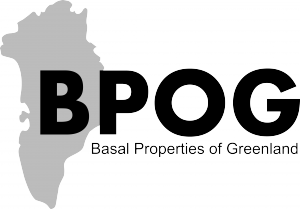
Basal Properties of Greenland (BPOG) is a NERC-funded project led by Professor Jonathan Bamber – Bristol Glaciology Centre, University of Bristol – in collaboration with many international project partners. The project’s main aim is to further understand the nature of the bed of the Greenland ice sheet as well as how it links to adjacent bathymetry.
Why?
More information about Greenland’s bed topography and surrounding bathymetry is available now than ever before. By bringing all of this information together – and filling in the gaps in areas where we still lack data – we have compiled the most comprehensive dataset to date detailing the bed of Greenland. Information on Greenland’s bed rock topography is essential to advance our knowledge of the sensitivity of ice sheet dynamics. As many glaciers of Greenland terminate in the ocean, considering the nature of the sea floor – bathymetry – surrounding Greenland in addition to the bed rock beneath the ice sheet enables a better understanding of how and why the ice sheet responds to ocean processes. In addition to the development of the bed dataset, further analyses have been carried out which have revealed some of the processes taking place beneath the ice, helping us explore how and why the dynamic nature of the Greenland ice sheet acts in the way that it does.
How?
We combined information from various sources. To assess bed elevation beneath the present day ice sheet, we analysed altimetry and ice penetrating radar data – largely collected by NASA through Operation Ice Bridge – which provided us with information on the current height of the ice sheet as well as the thickness of the ice from which we estimated bed rock elevation. To provide comprehensive bathymetry information, we have collated various marine surveys from researchers across the globe as well as integrating the new and extensive records such as have been collected through NASA’s Oceans Melting Greenland mission. Where observational information is still lacking, new methods have been developed to provide the most likely topography/bathymetry configurations.
Through extensive analysis of the available ice penetrating radar information that is now available, BPOG has endeavoured to determine physical properties of Greenland’s bed rock environment – such as the presence of liquid water and the bed rock roughness – at a higher spatial resolution than has been possible previously.
More information
- To see who is involved, see The Team page.
- To see the research article outputs associated with BPOG, see the Publications page.
- To access the newest available bedrock dataset, go to the Data Products page.
- To access some of the open source code developed through the project, go over to the Code page.
- For information on associated literature as well as data collection missions, take a look at the Additional Resources page.